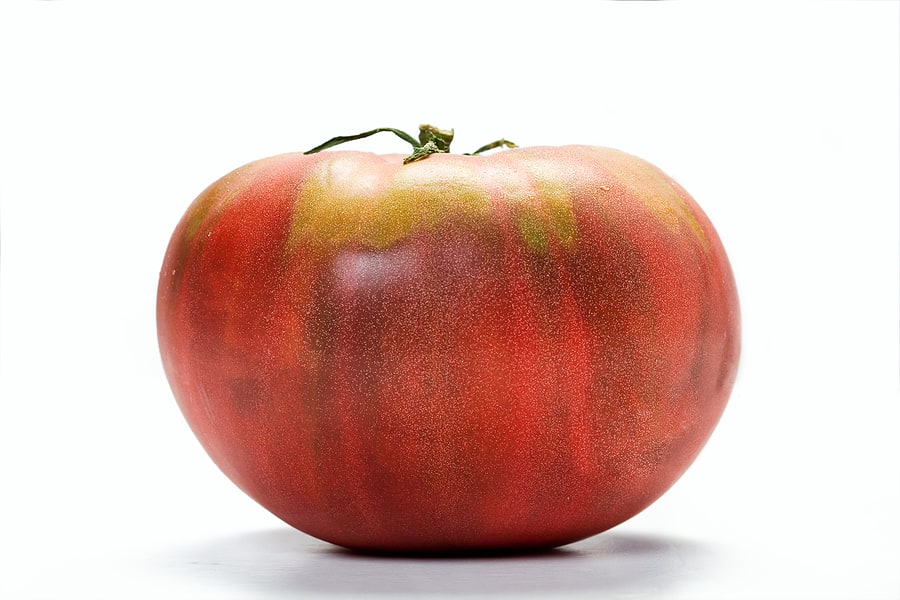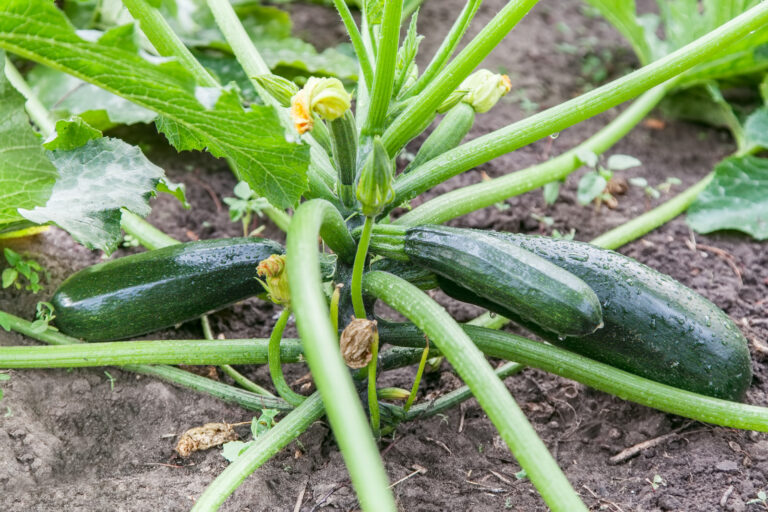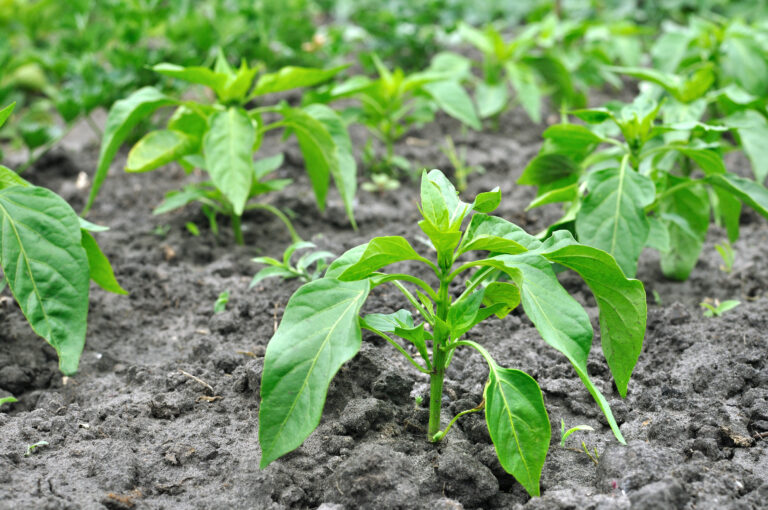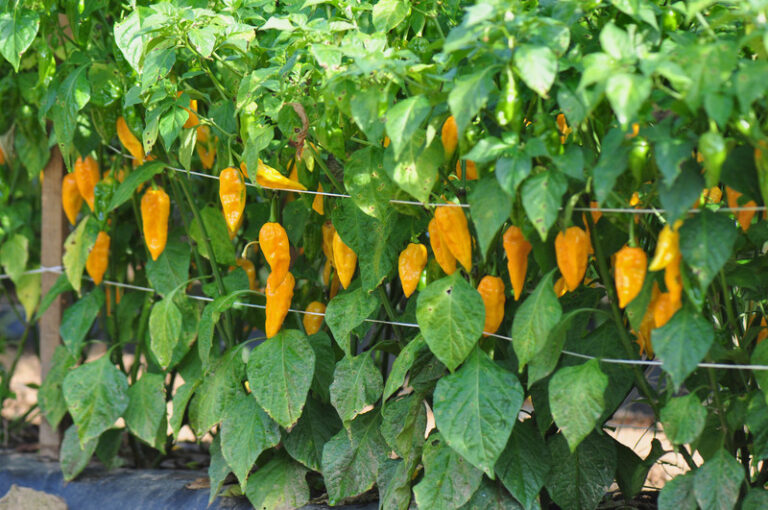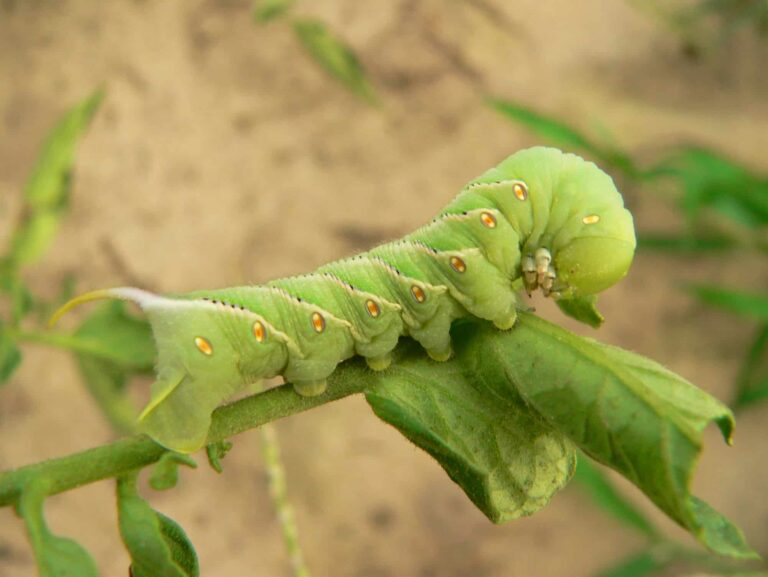Heirloom and Hybrid Tomatoes: Is One Better Than the Other?
Do heirloom tomatoes (or other heirloom vegetables, for that matter) have benefits or advantages when compared to hybrid tomatoes? The answer is not simple.
Natural selection of tomatoes
Most of the crops we eat today, including tomatoes, have evolved from less desirable wild plants. Over generations and generations, humans have selectively created many plant varieties through seed-saving and plant breeding.
A human-created plant variety is often called a cultivated variety or cultivar. (Nature can create new varieties as well: in nature, this happens when a group of plants in a certain species gets isolated from the main species–off in a valley or distant meadow, for example. In time, these plants become somewhat different than the rest of the species through isolated interbreeding.)
Most of the tomatoes we grow today are human-created cultivars that humans have named, e.g. ‘Brandywine’ and ‘Celebrity’ or ‘Early Girl’, for example, tomato cultivars. Thus the name Lycopersicon lycopersicum ‘Early Girl’ as you see on the label or seed packet.
Human breeding of tomatoes
When plant breeders find the desirable traits they want in a plant, they will quit breeding and start growing the plant just as it is and save its seeds to grow future crops. From that point, the next generations of that plant are more or less like the desirable parent plants. Plants grown by selecting seeds are called “open-pollinated cultivars.”
Heirloom tomatoes explained
An “heirloom variety” or “heirloom seed” is an open-pollinated plant variety that gardeners have grown and saved seed from for many years–usually 50 years or more. Heirlooms can be plants that gardeners have passed along through the generations, from one gardener to another or they can have a long commercial history–offered by seed companies since the cultivar was first created and introduced to the marketplace.
Heirlooms are plants that several generations of gardeners have liked enough to make sure they get passed on–so the benefits or advantages may be many–great flavor, easy to grow, pest or disease-resistant, or all of these and more. Heirlooms have withstood the test of time and the demands of gardeners.
Like many things, plants may come and go when it comes to popularity. Many heirloom tomatoes today have been “re-discovered”–that is they might have fallen out of popular use or acceptance as new plant cultivars were introduced and more widely distributed. These “new” heirlooms are just as good as they used to be–now they are regaining traction among growers.
So are there benefits to open-pollinated heirloom tomatoes?
Hybrid tomatoes explained
A hybrid is a plant or animal that is not like its parents: horse + donkey = mule, a hybrid. Two different species produce a hybrid. In the plant world, hybrids are usually made not by crossing two different species, but by crossing two different varieties within the same species.
When you see the word “hybrid” used to describe a plant cultivar what is almost always meant is that this plant is an F-1 hybrid, which means it is the first generation of two parents each of whom was bred in isolation for a very desired trait. When the genetic information for each of the parents with the desired trait was uniform or stable, the breeder crossed those two parents to create the F-1 hybrid, the best of both parents! The seed from this cross will be the hybrid seed that is sold as F-1.
When you see a plant is an F-1 hybrid–the inference is that it is a plant or seed that has very desired qualities. The seed grower will use these same parents each time she wants to produce more F-1 (first filial generation) hybrid seeds.
Tomato Grower’s Answer Book
Hybrid tomato advantages and disadvantages
Which is better: open-pollinated heirloom or hybrid? If you buy an F-1 hybrid you are going to get a plant that is the same as the last F-1 you grew. It comes from the same parents. The ‘Early Girl F-1’ tomato will be genetically the same as every other ‘Early Girl F-1’ tomato: they will grow the same in all respects–days to maturity, disease resistance, and flavor. With F-1 hybrids you get the advantage of what is often called “hybrid vigor”–the best of the parent plants and the work of the plant breeders to develop that hybrid.
But here’s a minus side to hybrids (warning: gets to be a bit Botany 101), if you collect the seed from F-1 hybrids they are not the seed of the original parents–they are offspring of the super-parents, the F-1. The seed of F-1 hybrids will not breed true to the next generation; they will not grow true to the traits of the F-1’s parents.
The offspring of F-1s begin reverting to all sorts of traits from their genetic past. Only about one-fourth of the offspring of F-1 hybrids will retain the qualities of the F-1 and its super parents. So F-1 hybrids are not stable for breeding or growing from seed. Practically speaking, that means you have to buy F-1 hybrid seeds or plants new each year. The positive: is hybrid vigor; the minus: is the cost of purchasing seeds each year.
Open-pollinated seeds–most heirlooms–can be saved and replanted year after year. Positive–you save money. You don’t have to rebuy seeds every year. (Of course, open-pollinated plants can cross-pollinate with other open-pollinated plants, but that is another can of worms or seeds.)
Heirloom tomato advantages
So if you find an open-pollinated plant or heirloom that you like: it has the flavor and growing characteristics you like and it has disease resistance (if that is important to you) then it certainly will have one advantage over a hybrid you like, it will cost you less in the long run.
One more thing about heirlooms and open-pollinated seeds and plants, it is a good thing to help keep old cultivars alive–genetic variability is the spice of life. Many old varieties–heirlooms–exist because they have great flavor, color, and form. Open-pollinated seeds and plants of the same variety or cultivar may vary from one to another more than F-1 hybrids (you’ll notice there are several different cultivars of ‘Brandywine’ tomato, for example), but that just makes it all the more interesting. These plants are worth growing and passing on to your grandchildren.)
Best of both
Grow both hybrid and heirloom tomatoes. Grow different varieties of each. Keep notes on growing habits and performance. Taste test the tomatoes you grow. Keep a list of those you would grow again. There are more than 15,000 named tomato varieties. There are plenty to choose from and plenty to like.
Heirloom open-pollinated tomato varieties
Tomato seeds from open-pollinated varieties can be saved for planting next year. Open-pollinated plants are allowed to pollinate each other in the open garden. Because tomatoes are self-pollinating plants (meaning male and female flower parts exist in the same flower), open-pollinated tomatoes are generally predictable and consistent (more below on hybrids and heirlooms). Collect seeds from any of these tomatoes for planting again next season.
Here are well-known heirloom tomato varieties:
- 1884. 78 days. Indeterminate; red beefsteak 16 ounces; excellent old-fashioned flavor; heirloom.
- Abraham Lincoln. 80-90 days. Indeterminate; red globe shape; clusters of up to 9 fruits; meaty, smooth sweet flavor.
- Ace 55. 80 days. Indeterminate; red globe shape to 7 ounces; low acid, tart flavor.
- Aker’s West Virginia. 85 days. Indeterminate; red beefsteak to 1 pound; excellent flavor; West Virginia heirloom.
- Amish Paste. 85 days. Indeterminate; red paste to 8 ounces; sweet flavor; Amish heirloom.
- Amana Orange. 90 days. Indeterminate; orange beefsteak to 5 inches in diameter. Mild flavor. From Amana, Iowa.
- Anna Russian. 70 days. Indeterminate; red oxheart to 1 pound; outstanding flavor; heirloom from Russia.
- Arkansas Traveler. 85 days. Indeterminate; pink globe shape; mild flavor, juicy; heat and humidity tolerant; pre-1900.
- Aunt Ginny’s Purple. 80 days. Indeterminate; black-purple beefsteak, 12 to 16 ounces; excellent flavor; German heirloom.
- Aunt Ruby’s German Green. 80 days. Indeterminate; green beefsteak, from 12 to 16 ounces; sweet, spicy; heirloom.
- Aussie. 85 days. Indeterminate; red beefsteak to 5 inches across; mild flavor, late maturity.
- Azoychka. 60 days. Indeterminate; yellow globe to 3½ inches in diameter, slightly flattened. Russian heirloom.
- Banana Legs. 75 days. Indeterminate; yellow paste; resembles a banana. Heirloom; also called South American Banana.
- Bear Creek. Indeterminate; black-purple globe shape.
- Beefsteak (Crimson Cushion). 90 days. Indeterminate; red beefsteak; meaty, juicy, rich flavor; for home gardens.
- Big Rainbow. 90-100 days. Indeterminate; red-orange multicolor beefsteak, some to 2 pounds; will crack and catface.
- Black Cherry. 65 days. Indeterminate; black-purple cherry; sweet, complex flavor.
- Black Krim. 75 days. Indeterminate; red globe shape from 8 to 12 ounces; full flavor, slightly salty; from Russia.
- Black Russian. 75 days. Indeterminate; black-purple globe shape; thrives in cool weather; heirloom.
- Black Zebra. 85 days. Indeterminate; multi-color globe.
- Blondkopfchen. 75-80 days. Indeterminate; yellow cherry borne in clusters of 20 to 30; each ½-inch in diameter; fruity flavor.
- Bloody Butcher. 55 days. Indeterminate; red globe shape.
- Bonny Best. 75 days. Indeterminate; red globe shape, from 6 to 8 ounces; meaty; widely adapted; introduced 1908.
- Box Car Willie. 80 days. Indeterminate; red globe shaped from 8 to 12 ounces; excellent flavor.
- Brandywine. 90 days. Indeterminate; pink-red beefsteak, 8 to 16 ounces; matures late in northern regions; Amish heirloom, 1885.
- Bull’s Heart. 87 days. Indeterminate; red oxheart to 4 inches long; old Russian heirloom; difficult to grow.
- Burbank. 80 days. Determinate; red globe shape, 6 to 8 ounces; very productive, developed about 1915 by Luther Burbank.
- Cherokee. 80 days. Determinate; large red globe shape, slightly flat to 7 ounces; firm, meaty; long harvest.
- Cherokee Purple. 80 days. Indeterminate; black-purple globe shape, 10 to 12 ounces, flavorful; originally from the Cherokee people.
- Chocolate Cherokee. 80 days. Indeterminate; black-purple globe shape.
- Costoluto Fiorentino. 80 days. Indeterminate; red ribbed from 6 to 8 ounces; good for canning.
- Costoluto Genovese. 78 days. Indeterminate; red ribbed; delicious, slightly tart flavor; good in warm or cool weather; old Italian variety.
- Crimson Cushion. 90 days. Indeterminate; large red ribbed, to 2 pounds; late season; old beefsteak variety.
- Dad’s Mug. 90 days. Indeterminate; pink-red mug shape; thick, nearly solid center; very flavorful; stuffing tomato; heirloom
- Dad’s Sunset. 75 days. Indeterminate; golden-orange round; meaty, tangy, each about 4 to 6 ounces.
- Delicious. 77 days. Indeterminate; red globe shape, usually more than 1 pound; solid meaty, very good flavor.
- Dinner Plate. 90-100 days. Indeterminate; red hear-shape for 24 to 30 ounces; delicious flavor; heirloom.
- Dora. 80-85 days. Indeterminate; black-purple globe shape.
- Druzba. 80-85 days. Indeterminate; red globe shape, 4 inches across; high acid; from Bulgaria.
- Dorothy’s Green. 80 days. Indeterminate; green ribbed to 8 ounces; sweet and tart, spicy overtones; heirloom.
- Dutchman. 80 days. Indeterminate; purple-pink scalloped, mild flavor, meaty with few seeds; from 1920 or earlier.
- Dwarf Champion. 80 days. Tree; pink globe shape to 5 ounces; mild flavor; for small gardens; from 1980.
- Earliana. 65 days. Indeterminate; red globe shape; clusters of 6 to 10 fruits to 5 ounces each; good in short-season regions; introduced in 1900.
- • Early Swedish. Indeterminate; red small round, from 3 to 4 ounces; excellent flavor; early variety.
- Emerald Evergreen. 76 days. Indeterminate; green globe shape.
- Garden Peach. 75-85 days. Indeterminate; yellow clusters; mild flavor; good keeper; heirloom.
- German Giant. 77 days. Indeterminate; deep pink beefsteak, flattened globe; use for juicing or salads.
- German Pink. 78 days. Indeterminate; pink beefsteak, 10 to 16 ounces; excellent, sweet flavor, meaty.
- German Red Strawberry. 85 days. Indeterminate; red oxheart to 10 ounces; German heirloom.
- Giant Belgium. 85 days. Indeterminate; large golden yellow, to 2 pounds; mild flavor, solid meat; mid-season harvest.
- Giant Paste. 75 days. Indeterminate; elongated red paste, 6 to 10 ounces; good yield.
- Golden Queen. 75 days. Indeterminate; golden globe shape; 8 to 12-ounce fruit; meaty, mild, sweet flavor, low acid; heirloom from 1882.
- Goldie. 85-95 days. Indeterminate; golden beefsteak; large, slightly flattened globe, mild flavor; 160-year-old heirloom.
- Goliath. 85 days. Indeterminate; dark pink ribbed very large fruit to 3 pounds; from the late 1800s.
- Great White. 85 days. Indeterminate; white beefsteak from 14 to 16 ounces; low acid; ripens midseason; heirloom.
- Green Bell Pepper. 76 days. Indeterminate; green pepper shape; use for stuffing.
- Green Grape. 70 days. Determinate; yellow-green cherry in clusters of 4 to 12 fruits; resembles a Muscat grape.
- Green Zebra. 78 days. Indeterminate; multi-color globe to 2½ inches in diameter; mild flavor; heirloom.
- Hayslip. 75 days. Determinate; red globe shape with green shoulders to 6 ounces.
- Hillbilly. 85 days. Indeterminate; yellow-orange bicolor to 2 pounds; heirloom from West Virginia via Ohio.
- Hungarian Heart. 85 days. Indeterminate; red oxheart to 1 pound; from a village near Budapest to America in 1901.
- Ida Gold. 59 days. Determinate; orange globe; small 2 to 3 ounces; mild, low-acid flavor.
- Jubilee. 72 days. Indeterminate; golden yellow canning.
- Liz Birt. 75 days. Indeterminate; red beefsteak.
- Marglobe. 75 days. Determinate; red globe shape from 6 to 10 ounces; meaty.
- Marmande. 65 days. Semi-determinate; red ribbed from 4 to 6 ounces; French heirloom.
- Marvel Stripe. 85 days. Indeterminate; yellow-orange bicolor ribbed to 2 pounds; very sweet; from Oaxaca, Mexico.
- Matchless. 85 days. Indeterminate; red flattened; high yield; introduced in 1894.
- Matt’s Wild Cherry. 55 day. Indeterminate; red cherry; rich flavor, high sugar content.
- Mister Stripey. 56 days. Indeterminate; multi-color beefsteak; low acid, mild flavor; English heirloom.
- Moneymaker. 80 days. Indeterminate; red globe shape to 4 ounces; heavy yield; adapted to high humidity; old English greenhouse variety.
- Mortgage Lifter (Radiator Charlie’s). 80-85 days. Indeterminate; red beefsteak, fruit to 4 pounds. Developed in West Virginia where a radiator repairman used the sales from this tomato to pay off his mortgage during the Great Depression.
- Moskvich. 60 days. Indeterminate; red globe shape from 4 to 6 ounces; rich taste, smooth texture; from Eastern Siberia.
- Mule Team. 80 days. Indeterminate; red glove shape from 8 to 12 ounces; sweet flavor with a slight tang.
- Nepal. 80 days. Indeterminate; red globe shaped from 10 to 12 ounces; intense flavor; from the Himalayan Mountains.
- New Big Dwarf. 90 days. Tree; pink beefsteak.
- Orange Jubilee. 70-80 days. Indeterminate; orange paste.
- Oregon Spring. 56 days. Determinate; red globe shape, to 4 pounds; very good flavor; for home gardens.
- Oxheart. 80 days. Indeterminate; red oxheart, 7-ounce fruits; adapted to high humidity; introduced in 1925.
- • Pantano Romanesco. 80 days. Indeterminate; red scalloped.
- • Paul Robeson. 75 days. Indeterminate; black beefsteak; earthy flavor; Russian heirloom.
- • Peron. 68 days. Indeterminate; red globe shape about 10 ounces; introduce from Greece in 1951.
- Persimmon. 80 days. Indeterminate; golden-orange ribbed; large, persimmon-colored; very flavorful; heirloom from the 1800s.
- Pineapple. 85 days. Indeterminate; red-yellow bicolor ribbed to 2 pounds; mild flavor.
- Polish Linguisa. 73 days. Indeterminate; red sausage-shaped paste from 8 to 10 ounces; eat fresh or cook; heirloom from 1800s.
- Ponderosa. 88 days. Indeterminate; large purple-pink flattened to 12 ounces and more, cluster of 3 to 5; late maturing; from 1891.
- Ponderosa Pink. 80 days. Tree; pink beefsteak.
- Porter’s Pride. 70 days. Indeterminate; red globe shape to 4 ounces; heavy yield in high temperatures and low humidity.
- Principe Borghese. 75 days. Determinate; red plum-shaped paste, about 1 to 2 ounces; very meaty; use for sun drying.
- Pruden’s Purple. 75 days. Indeterminate; dark pink globe shape to 1 pound; firm and meaty; widely adapted.
- Red Brandywine. 100 days. Indeterminate; red beefsteak.
- Red Cherry Large. 75 days. Indeterminate; red cherry to 1¼ inches in diameter; abundant clusters.
- Red Currant. 70 days. Indeterminate; red cherry; sweet-tart flavor; heavy yield; from South America.
- Red Pear. 78 days. Indeterminate; red miniature pear-shaped to 2 inches in diameter; sweet flavor.
- Reiner. 80-85 days. Determinate; red beefsteak.
- Roma. 75 days. Determinate; red paste plant produces up to 200 tomatoes per plant; meaty.
- Ruffled Yellow. 80 days. Semi-determinate; yellow pleated shape; excellent flavor.
- Rutgers. 75 days. Determinate; red globe shape from 6 to 8 ounces; tomato flavor; developed in 1928.
- San Marzano. 85 days. Indeterminate; red paste is borne in clusters; solid, meaty.
- Siberia. 50 days. Determinate; red globe shape to 7 ounces; 40 to 60 fruits per plant; does well in shade and containers; from Russia.
- Sioux. 70 days. Indeterminate; red globe shape; solid, meaty, medium-sized; dependable in hot weather.
- Snow White Cherry. 70 days. Indeterminate; white cherry; a good taste for snacking.
- Stone. 79 days. Indeterminate; red globe shape to 10 ounces; hold well; from the late 1800s.
- Striped German. 78 days. Indeterminate; yellow-red large ribbed to 2½ pounds; fruity flavor.
- Stupice. 52 days. Indeterminate; red globe shaped from 3 to 6 ounces; exceptional flavor; good yield; from Czechoslovakia.
- Sundrop. 70-76 days. Indeterminate; small orange globe shaped to 1¾ inches in diameter; meaty, sweet.
- Super Italian Paste. 73 days. Indeterminate; red paste to 10 ounces; heirloom.
- Sweetie. 70 days. Indeterminate; red cherry to 1½ inches in diameter; clusters of 15 to 20 fruits, good sugar content.
- Tappy’s Finest. 77 days. Indeterminate; pink-red large flattened globe; meaty, flavorful; West Virginia heirloom.
- Thessaloniki. 75 days. Indeterminate; large red globe shaped from 6 to 8 ounces; old-fashioned acid tomato flavor.
- Tigerella. 59 days. Indeterminate; multi-color globe to 2 inches in diameter; tangy tomato flavor.
- Tiny Tim. 45 days. Bush; red cherry to 1½ inches in diameter; does very well in containers.
- Ugly. 75 days. Indeterminate; red ribbed beefsteak from 12 to 16 ounces; old-fashioned flavor; early.
- Valena Pink. 85 days. Indeterminate; pink beefsteak.
- Valencia. 76 days. Indeterminate; orange fruit from 8 to 10 ounces; smooth, flavorful; Maine heirloom.
- Variegated. 75 days. Indeterminate; red globe shape.
- Violaceum Krypni-Rozo. 80 days. Indeterminate; pink scalloped, up to 2 pounds; sharp-sweet taste; French heirloom.
- Watermelon Beefsteak. 75 days. Indeterminate; scalloped pink beefsteak to 1 pound or more; rich, sweet flavor.
- White Wonder. 80 days. Indeterminate; white beefsteak; high sugar content.
- Yellow Brandywine. 100 days. Indeterminate; yellow beefsteak, 3 to 4 inches in diameter, flattened; very good flavor.
- Yellow Currant. 70 days. Indeterminate; yellow cherry to ½ inch in diameter.
- Yellow Marble. 66 days. Indeterminate; yellow cherry marble sized; very sweet.
- Yellow Pear. 78 days. Indeterminate; yellow miniature pear-shaped to 2 inches long; very sweet; continuous harvest.
- Zapotec Pink Ribbed. 80 days. Indeterminate; pink ribbed, bell pepper shaped; stuff or bake; from Oaxaca, Mexico.
Hybrid tomato varieties
- Better Boy. 72 days. Indeterminate; prolific producer; flavorful, disease-resistant.
- Big Boy. 78 days. Indeterminate; smooth bright red fruit; great flavor; sandwich-type slicer.
- Black Pearl. 65 days. Indeterminate; multicolored fruit; Concord grape-like flavor cherry
- tomato.
- Celebrity. 70-75 days. Semi-determinate. Great flavor slicing tomato; disease resistant.
- Champion. 65 days. Indeterminate; sweet, meaty, few seeds, heat tolerant.
- Early Girl. 62 days. Indeterminate; clusters of deep-red fruit; sweet tomato flavor; grows in cool regions.
- Goliath. 65 days. Indeterminate beefsteak; sweet flavor; fruit to 15 ounces.
- Juliet. 60-70 days. Indeterminate; clusters of grape-like fruits; sweet plentiful; crack-resistant.
- Legend. 68 days. Determinate; sweet flavor with slight acidity; tolerates late blight.
- Lemon Boy. 72 days. Indeterminate; vigorous growth.
- Napa Grape. 65 days. Indeterminate; fruit to about 1 inch; high sugar; great flavor.
- New Girl. 61 days. Indeterminate; deep red fruit; sweet with high acidity.
- Roma. 75 days. Italian plum with sweet, firm flesh; good cooking and storage tomato.
- San Marzano. 80 days. Indeterminate; prolific fruiting; plum tomato; disease resistant.
- Steakhouse. 75-80 days. Indeterminate; delicious and fragrant; each fruit can grow to 3 pounds.
- Supersweet 100. 65-70 days. Indeterminate; delicious red cherry tomatoes.
- Supertasty. 70 days. Determinate; rich, tangy flavor.
- Sungold. 65 days. Indeterminate; orange-gold cherry tomato.
- Sun Sugar. 62 days. Indeterminate; small, sweet cherry tomatoes resist cracking.
- Sweet 100. 62 days. Indeterminate; sweet cherry tomatoes.
- Tye-Dye. 78 days. Indeterminate; gold-red fruit; all-around use.
Tomato Growing Hub
Start here: The Ultimate Tomato Growing Guide: From Seed to Harvest
Growing Tips
- Getting Started with Tomatoes: A Gardener’s Guide to Success
- How to Choose a Tomato for Your Garden
- Growing Early-Season Tomatoes for Great Taste
- Heirloom and Hybrid Tomatoes
Planting Tips
- Tomato Seed Starting Tips
- Mastering Tomato Seed Starting: How to Grow Strong and Healthy Plants Indoors
- When to Plant Tomatoes: A Gardener’s Guide to Timing and Success
- Plant Tomatoes for a Thriving Crop: Sun, Soil, and Spacing
- How to Transplant Tomato Seedlings: A Gardener’s Guide
- Growing Tomatoes in Containers
Tomato Care
- Watering and Feeding Tomatoes: Expert Tips for a Healthy, Productive Crop
- Best Ways to Support Your Tomato Plants
- Pinching and Pruning Tomatoes: A Gardener’s Guide to Healthier, More Productive Plants
- How to Prune Tomatoes
- Grow Tomatoes on Stakes
- Best Companion Plants for Thriving Tomatoes: What Works & What to Avoid
Pest & Disease Control
- Tomato Growing Problems: Pests, Diseases, and Solutions
- How to Prevent Blossom Drop — Tomatoes and Peppers
- How to Identify Early Blight, Late Blight, and Leaf Spot on Tomatoes
Harvest & Preparation
- When and How to Harvest Tomatoes for the Best Flavor
- How to Ripen Tomatoes
- Planting Tomatoes for a Long Harvest
- Planting Tomatoes for a Fall Harvest: How to Grow Fresh Tomatoes Before Frost
- Tomato Flavor Explained
- Nine Ways to Cook and Serve Tomatoes
Garden Planning Books at Amazon:
- Tomato Grower’s Answer Book
- Vegetable Garden Almanac & Planner
- Kitchen Garden Grower’s Guide Vegetable Encyclopedia
- Vegetable Garden Grower’s Guide
Books to help you grow:

